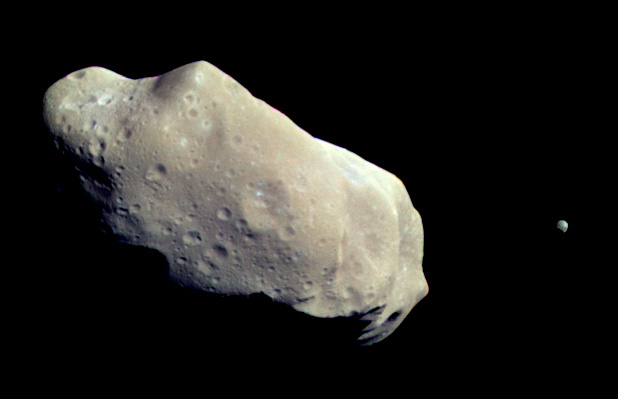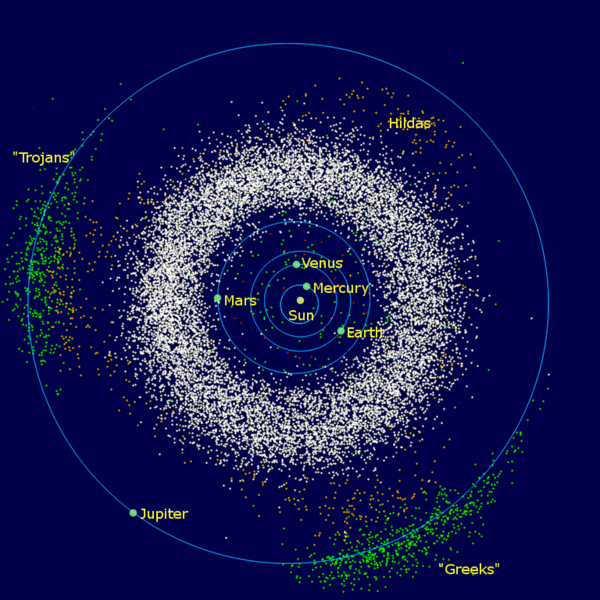Having written about the massive planets (and one shrouded moon) of the outer solar system now seems as good a time as any to talk about the boundary separating the gas giants and the neighborhood of the terrestrial planets. Between the orbits of Mars and Jupiter lies a sparsely populated region of very small bits of rock called the Asteroid Belt. I use sparsely here to say that the asteroids themselves are numerous (somewhere between one and two million notable ones) but they are spread very thinly throughout the 200 million mile region. When picturing the belt, some might think of that scene from Star Wars, with many large rocks zipping around perilously close the spaceship unlucky enough to pass through.
In reality, if you were standing on the average asteroid, the next nearest would be so faint and far away (not to mention small) that it would be invisible. Scientists have sent many ships though the belt with little to no problems from any asteroid. Density of distribution aside, asteroids are small. I mean, really, really small. The total mass of the entire Asteroid Belt is less than a quarter of Pluto’s mass, with roughly half of that mass belonging to the four largest asteroids: 1 Ceres, 4 Vesta, 2 Pallas, and 10 Hygiea (numbered by order of discovery). Ceres itself is the most massive asteroid, comprising roughly a third of the entire belt’s mass. The other “notable” asteroids (and there are millions) range in size from a mile or so down to grains of sand.

Pluto, its moon, and the two largest asteroids to scale (via Blogspot)
In the 17th century, two men by the names of Johann Daniel Titius and Johann Elert Bode noticed that the orbits of the planets known at the time to follow a pattern that made each subsequent planet roughly twice as far from the Sun as the planet before it. With an incredible amount of imagination, this was named the Titius-Bode Law. It lined up with Uranus’ orbit once it was discovered, which reinforced the belief in the law. It also predicted that a planet should orbit between Mars and Jupiter, a place where there was a curious gap (we now know it was just a clever bit of mathematics after it failed to coincide with Neptune’s orbit to such a degree that it was disproven, but I digress). Astronomers took notice and quickly set to the task of finding whatever lay in that region. A group was chosen, each with a specified region of sky to search. Giuseppe Piazzi beat them all to the punch and made his own discovery of a moving star just past the orbit of Mars. Having originally thought it to be a comet, its orbit was calculated to be not nearly as eccentric, nor far-flung as to be a comet (comets have very thin oval shaped orbits that carry them from one end of the solar system and back). Thus, on January 1, 1801, the new year was rung in with a new planet: Ceres.
If the Asteroid Belt is analogous to the Kuiper Belt, then Pluto being the largest Kuiper Belt Object must be paralleled by Ceres. Pluto was thought to be a planet, but after finding more and more objects, it was reclassified as a dwarf planet, orbiting within a region of similar bodies. Ceres is also a dwarf planet and was realized to be such after the discovery of many other asteroids in similar orbits (though Ceres was discovered 130 years before Pluto, and before the Kuiper Belt, was thought to exist).
The fourth asteroid discovered, and the second largest, is Vesta. Vesta is my personal favorite asteroid and it is a rather peculiar one. When an object becomes massive enough, its gravity will make it spherical. It is then said to be in hydrostatic equilibrium. Around this time, an object tends to be hot enough to become differentiated, or layered into (roughly) crust, mantle, and core. All the terrestrial planets are differentiated, as well as some larger moons. A billion or so years ago, an impact struck Vesta after it had differentiated, punching through the crust and ejecting material from its mantle out into space. Some of this debris remained in orbit near Vesta, while some were sent inward where it was attracted by Earth’s gravity. A specific type of meteorite fell to Earth and was collected (very much after the fact) by scientists, who, after confirmation from the Dawn mission, were then able to determine its origin to be Vesta. While this seems a little science-fictiony, Vesta is not nearly as massive as Earth, so when it was struck, it couldn’t hold onto its material easily, allowing it to travel through the solar system. Similar impacts have struck Mars, and we even have small Martian meteorites (called shergottites) here on Earth (just ask Martian geologist Dr. Keith Milam, here at OU).

A video of Vesta’s rotation. The remanent of the impact that sent debris to Earth is seen on the southern hemisphere (via Wikimedia Commons)
Another interesting asteroid is actually a pair, Ida and Dactyl. Ida is the first asteroid to be known to have an orbiting satellite. When the Galileo probe flew past it en route to Jupiter, it observed tiny Dactyl circling Ida, though it was unable to take any accurate measurements of the exact path of the orbit. It is rather astounding that Ida is able to even hold onto Dactyl, being 17 times smaller than Vesta, but then Dactyl is even smaller, measuring less than a mile across at its widest. Ida is by no means the only asteroid with a moon. Some even have multiple moons or even rings, but data on these is limited.

Ida and its satellite Dactyl (via Wikimedia Commons)
Jupiter plays a major role in shaping the orbits within the Asteroid Belt. Being so close to the massive planet, the orbital resonances that are created routinely cause the much smaller asteroids to be perturbed out of orbit. Most notable is the 3:1, 5:2 and 2:1 resonances, with a steep drop-off of asteroids nearer to Jupiter than those asteroids that orbit twice for every one Jovian orbit. As an asteroid passes Jupiter, Jupiter’s strong gravity pulls the asteroid backward, lowering its speed and sending it inward toward the Sun. Another asteroid could be pulled forward, its increased speed extending its orbital radius. As the asteroid moves closer to Jupiter, an interesting interaction occurs between the three bodies. Around any two massive objects, there will be five regions, called LaGrange Points. where the gravitational fields of both are equal. Three of these (on either side of the planet and on the far side of the Sun) are only quasi-stable. The remaining two are exactly 60 degrees ahead and behind the planet along its orbit. If a third, much less massive, object were to be pulled into either of those points, an equilateral triangle can be made between all three objects. In the case of Jupiter, the asteroids that are captured here are known as the Trojan asteroids.

The locations of the known major asteroids in solar orbit (via Wikimedia Commons)






